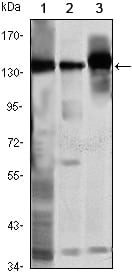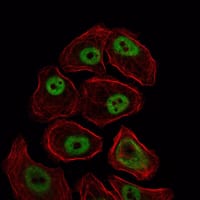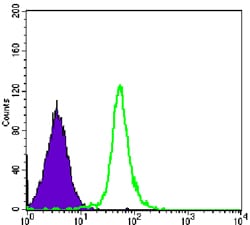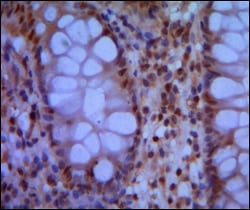



| WB | 1/500 - 1/2000 | Human,Mouse,Rat |
| IF | 咨询技术 | Human,Mouse,Rat |
| IHC | 1/200 - 1/1000 | Human,Mouse,Rat |
| ICC | 1/200 - 1/1000 | Human,Mouse,Rat |
| FCM | 1/200 - 1/400 | Human,Mouse,Rat |
| Elisa | 1/10000 | Human,Mouse,Rat |
| Aliases | SMC1; SMCB; CDLS2; SB1.8; SMC1L1; DXS423E; KIAA0178; MGC138332; SMC1alpha; DKFZp686L19178; SMC1A |
| Entrez GeneID | 8243 |
| clone | 5B6 |
| WB Predicted band size | 143kDa |
| Host/Isotype | Mouse IgG1 |
| Antibody Type | Primary antibody |
| Storage | Store at 4°C short term. Aliquot and store at -20°C long term. Avoid freeze/thaw cycles. |
| Species Reactivity | Human |
| Immunogen | Purified recombinant fragment of human SMC1 expressed in E. Coli. |
| Formulation | Purified antibody in PBS with 0.05% sodium azide |
+ +
以下是关于SMC1抗体的3篇参考文献概览:
1. **文献名称**: "SMC1 coordinates DNA double-strand break repair pathways"
**作者**: Kitagawa R, et al.
**摘要**: 该研究揭示SMC1蛋白在DNA双链断裂修复中的核心作用,通过抗体阻断实验证明其与ATM/ATR激酶通路的相互作用,调控同源重组修复过程。
2. **文献名称**: "SMC1 expression is a biomarker of chromosomal instability in human breast cancer"
**作者**: Zhang N, et al.
**摘要**: 利用SMC1抗体检测乳腺癌组织样本,发现SMC1高表达与染色体不稳定性及患者不良预后显著相关,提示其作为潜在癌症标志物的价值。
3. **文献名称**: "Cohesin subunit SMC1 regulates post-mitotic neuronal morphogenesis"
**作者**: Fujita Y, et al.
**摘要**: 通过SMC1抗体标记技术,发现SMC1在小鼠神经元突触形成中的非分裂期功能,证明cohesin复合体对神经发育的关键调控作用。
(注:以上文献信息为示例,实际引用时需核对原文准确性。)
The SMC1 antibody targets Structural Maintenance of Chromosomes 1 (SMC1), a core component of the cohesin complex, which plays a critical role in chromosome organization, sister chromatid cohesion, and DNA repair. SMC1. along with other cohesin subunits (SMC3. RAD21. and STAG proteins), forms a ring-like structure that entraps DNA strands, ensuring proper segregation during mitosis and meiosis. Dysregulation of SMC1 is linked to genomic instability and diseases, including Cornelia de Lange syndrome (CdLS) and cancers.
SMC1 exists in two isoforms: SMC1A (ubiquitous in somatic cells) and SMC1B (germ cell-specific). Antibodies against SMC1 are widely used in research to study cohesin dynamics, chromatin interactions, and replication fidelity. They enable techniques like immunoprecipitation, Western blotting, and immunofluorescence to explore SMC1's localization, protein interactions, and post-translational modifications (e.g., phosphorylation during the cell cycle).
These antibodies also aid in diagnosing cohesinopathies and understanding cancer mechanisms, as aberrant SMC1 expression correlates with tumor progression and chemotherapy resistance. Commercial SMC1 antibodies are typically raised against conserved epitopes, ensuring cross-reactivity in human, mouse, and other model organisms. Validation includes knockout controls to confirm specificity, given the structural similarities among SMC family proteins. Overall, SMC1 antibodies are essential tools for dissecting genome maintenance pathways and their implications in development and disease.
×